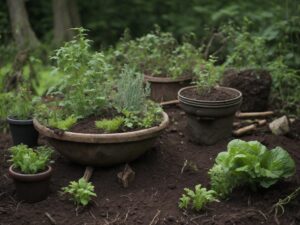
Importance of Survival Gardening
Ensuring Food Security in Emergencies
In times of emergencies or natural disasters, having a survival garden can be a lifesaver. When traditional food sources may be scarce or inaccessible, a well-planned survival garden can provide you and your family with a consistent supply of fresh and nutritious food. By growing your own fruits, vegetables, herbs, and even medicinal plants, you can ensure that you have a reliable food source, regardless of external circumstances.Developing Self-Sufficiency
Survival gardening is not just about preparing for emergencies, but also about developing self-sufficiency in your daily life. By cultivating your own food, you become less dependent on grocery stores and the industrial food system. You have control over what you grow, the quality of the produce, and the methods used. This not only gives you a sense of empowerment and autonomy but also allows you to make healthier and more sustainable choices for yourself and the environment.Saving Money on Groceries
One of the most significant benefits of survival gardening is the potential to save money on groceries. By growing your own food, you can significantly reduce your grocery bills. The costs associated with buying seeds or seedlings, gardening tools, and fertilizers are often minimal compared to the amount of produce you can yield. Additionally, growing your own food eliminates the need for transportation and packaging, further cutting down on costs. With a well-managed survival garden, you can enjoy fresh organic produce without breaking the bank.Choosing the Right Plants for a Survival Garden
Nutrient-Dense Vegetables
When selecting plants for your survival garden, prioritize nutrient-dense vegetables that offer a high nutritional value. Leafy greens like kale, spinach, and Swiss chard are packed with essential vitamins and minerals. Other vegetables, such as tomatoes, peppers, and carrots, provide a wide range of nutrients and can be grown in various climates. Aim to include a diverse range of vegetables to ensure a balanced diet and maximize the nutritional benefits of your garden.Perennial Herbs and Fruits
In addition to vegetables, consider incorporating perennial herbs and fruits into your survival garden. Perennials are plants that live for more than two years, which means they require less effort for replanting each season. Herbs like sage, rosemary, and thyme not only add flavor to your meals but also have medicinal properties. Fruits such as strawberries, raspberries, and blueberries provide a delicious and nutritious addition to your garden, while also attracting beneficial pollinators.Quick-Growing Crops
When planning a survival garden, it’s essential to include quick-growing crops that yield results within a relatively short period. These crops can provide you with a rapid food source in case of immediate need or when waiting for other plants to mature. Consider fast-growing vegetables like lettuce, radishes, and green beans. These crops can be harvested within weeks, allowing you to enjoy fresh produce sooner rather than later.
Container Gardening for Limited Spaces
Utilizing Small Balconies and Patios
If you have limited outdoor space, container gardening is an excellent solution. Small balconies and patios can be transformed into thriving gardens with the use of containers. Select pots or raised beds appropriate for the size and weight of the plants you intend to grow, ensuring they have proper drainage. Herbs, salad greens, and dwarf fruit trees can all thrive in containers, providing you with fresh produce within arm’s reach.Vertical Gardening Techniques
Vertical gardening is another space-saving technique that maximizes the use of vertical space, making it ideal for small gardens. By using trellises, stakes, or hanging baskets, you can grow plants vertically, allowing you to grow more in a limited area. Vining crops such as cucumbers, beans, and tomatoes can be trained to grow vertically, saving valuable ground space for other plants. The upward growth of plants in a vertical garden not only provides an efficient use of space but also adds an aesthetic appeal.Choosing Compact Varieties
When choosing plants for container or limited-space gardens, opt for compact varieties specifically bred for small-scale gardening. These varieties are often more suitable for container growth and have a smaller mature size, making them easier to manage in confined spaces. Look for terms like “bush,” “dwarf,” or “patio” when selecting compact varieties. These plants are designed to thrive in containers and can provide abundant yields despite their smaller stature.Planning and Designing a Survival Garden
Assessing Available Space and Sunlight
Before starting your survival garden, it’s crucial to assess the available space and sunlight in your gardening area. Take note of which areas receive the most sunlight throughout the day and plan your garden layout accordingly. Determine the dimensions of your garden and consider any potential obstacles or challenges, such as shade from buildings or trees. By understanding your garden’s unique conditions, you can choose the right plants and optimize their growth.Creating a Crop Rotation Plan
To ensure the long-term success of your survival garden, it’s important to develop a crop rotation plan. Crop rotation involves changing the location of plants within your garden each growing season to minimize the risk of pests and diseases. Rotating crops helps prevent the buildup of specific pests or diseases that target certain plant families. Additionally, crop rotation helps maintain soil fertility by balancing nutrient demands. Consider dividing your garden into different sections and rotating crops according to plant families or nutrient requirements.Building Raised Beds or Containers
Raised beds or containers are excellent options for survival gardens, as they offer several advantages. Raised beds provide better soil drainage and aeration, preventing waterlogging and enhancing root growth. They also allow for easier weed control and can extend the growing season by warming up the soil more quickly in the spring. Building raised beds or selecting suitable containers also enables you to create customized gardening spaces, catering to individual plant needs and maximizing your gardening efficiency.
Storing Seeds for Long-Term Survival
Seed Saving Techniques
Storing seeds for long-term survival is essential to maintaining a sustainable source of future crops. Seed saving involves harvesting and preserving seeds from mature plants for future use. To save seeds successfully, ensure you choose open-pollinated plants and allow the seed heads or pods to fully mature before harvesting. Clean and dry the seeds thoroughly before storing them in a cool, dry, and airtight container. Properly saved seeds can last for several years, ensuring you have a continuous supply of seeds for future planting.Proper Storage Conditions
To preserve the viability of your stored seeds, it’s crucial to provide them with proper storage conditions. Seeds should be kept in a cool, dry, and dark place to minimize exposure to light, heat, and moisture. The ideal temperature for seed storage is around 40°F to 50°F (4°C to 10°C), with low humidity levels. Airtight containers, such as glass jars or seed storage envelopes, can help protect seeds from moisture and pests. Regularly check stored seeds for any signs of deterioration or mold to prevent the spread of damage.Best Types of Seeds to Store
When selecting seeds to store for long-term survival, focus on varieties that are known for their adaptability, productivity, and nutritional value. Heirloom seeds, which are open-pollinated and have been passed down through generations, are often favored for their genetic diversity and resilience. Additionally, prioritize staple food crops like corn, beans, squash, and grains, as these provide a reliable source of calories. It’s also beneficial to store seeds of crops that can withstand various growing conditions, such as drought or extreme temperatures.Understanding Soil and Compost
Testing Soil Quality
Understanding your soil’s quality is essential for successful gardening. Conduct soil tests to assess its pH level, nutrient content, and texture. Soil pH affects nutrient availability to plants, with most vegetables preferring a slightly acidic to neutral pH range. Test kits or laboratories can provide accurate pH readings, allowing you to adjust the soil’s acidity or alkalinity if needed. It’s also crucial to test for nutrient deficiencies, as this will guide you in selecting appropriate fertilizers or organic amendments to improve soil fertility.Amending Soil with Compost
Compost is a valuable organic material that improves soil structure, fertility, and moisture retention. Adding compost to your survival garden helps replenish organic matter, enhances microbial activity, and promotes healthy plant growth. Compost is rich in nutrients and provides slow-release fertilization, reducing the need for synthetic additives. Prioritize making your compost with kitchen scraps, yard waste, and other organic materials to create a sustainable and nutrient-rich soil amendment for your garden.Creating a Composting System
To ensure a constant supply of compost for your survival garden, it’s beneficial to establish a composting system. Begin by designating an area for composting, either with a compost bin or a dedicated pile. Layer organic materials, such as kitchen scraps, leaves, grass clippings, and coffee grounds, in a balanced ratio of green (nitrogen-rich) to brown (carbon-rich) materials. Regularly turn or mix the compost pile to promote decomposition and aerobic conditions. With time, you’ll have a steady supply of compost to enhance the health and fertility of your garden soil.
Managing Pests and Diseases in a Survival Garden
Implementing Natural Pest Control Strategies
In a survival garden, it’s important to manage pests and diseases in a sustainable manner. Implement natural pest control strategies to reduce reliance on synthetic pesticides and protect the health of your plants. Encourage beneficial insects, such as ladybugs and lacewings, by planting companion plants that attract them. Use physical barriers like row covers or netting to block pests from accessing your plants. Introduce natural predators like praying mantises or beneficial nematodes to control pest populations. Regularly inspect your plants for signs of pests or diseases and take prompt action to prevent their spread.Identifying Common Garden Pests
To effectively manage pests in your survival garden, it’s crucial to be able to identify common garden pests. Aphids, caterpillars, slugs, and snails are among the most common insect pests that can cause damage to your plants. Look out for visible signs such as chewed leaves, holes or tunnels, discolored foliage, or wilting plants. Additionally, be aware of common diseases such as powdery mildew, blight, or root rot, which can weaken or kill your plants. By promptly identifying and addressing pest and disease issues, you can protect the overall health of your survival garden.Promoting Plant Health and Disease Resistance
Maintaining the overall health and vitality of your plants is key to preventing pest and disease problems in a survival garden. Focus on proper plant care, including providing adequate water, nutrition, and sunlight. Avoid overcrowding plants, as this can create favorable conditions for pests and diseases. Regularly remove weeds, as they can compete with your plants for resources and become hosts for pests. Consider companion planting and crop rotation to deter pests and diseases naturally. By promoting plant health and disease resistance, you create a resilient and flourishing survival garden.Harvesting and Preserving the Harvest
Knowing When to Harvest
Knowing when to harvest your crops is crucial for optimal flavor, nutrient content, and storage potential. Each vegetable, fruit, and herb has its own indicators of ripeness. Learn about the specific signs to look for, such as color changes, size, texture, or taste. Harvest leafy greens when they are still young and tender, before they become woody or bitter. For fruits and vegetables, harvest them when they reach their peak ripeness for the best flavor and texture. Regular monitoring and observation of your plants will help you determine the perfect time to harvest.Storing Fresh Produce
Proper storage of fresh produce is essential to prolong its shelf life and maintain its quality. Certain crops, such as root vegetables and some fruits, can be stored in a cool and dark place, such as a root cellar or a refrigerated pantry. Leafy greens are best stored in airtight containers or bags in the refrigerator to retain their crispness. Herbs can be stored by placing them in a jar of water, similar to cut flowers, or by drying them for later use. Understanding the storage requirements for each crop will help you enjoy the fruits of your survival garden for an extended period.Preserving Food through Canning, Freezing, and Drying
Preserving excess harvest through canning, freezing, or drying methods allows you to enjoy homegrown produce long after the growing season has ended. Canning involves heat processing fruits, vegetables, or sauces to create a shelf-stable product. Freezing vegetables and fruits involves blanching them briefly before storing them in the freezer. Drying herbs, fruits, or vegetables can be accomplished using a food dehydrator, an oven, or by air drying. Preserving food not only extends its storage life but also enables you to have a variety of homegrown ingredients readily available throughout the year.
Medicinal Plants for a Survival Garden
Herbs and Plants with Medicinal Properties
In a survival garden, it’s beneficial to include herbs and plants that have medicinal properties. These plants can serve as a natural first-aid kit, providing remedies for common ailments or injuries. Some commonly cultivated medicinal plants include aloe vera for burns and skin irritations, chamomile for soothing digestion and promoting sleep, and echinacea for immune system support. Research different medicinal plants and their uses to determine which ones align with your needs and interests.Creating a First Aid Kit with Garden Remedies
By cultivating medicinal plants in your survival garden, you have the opportunity to create a first aid kit with garden remedies. Harvest and prepare the plants accordingly to create topical salves, tinctures, infusions, or poultices for various health concerns. For example, calendula flowers can be infused in oil to create a soothing salve for minor cuts and bruises. Lavender flowers can be used to make a calming tea or essential oil for relaxation. Having homemade remedies at your disposal can be invaluable in a survival situation when regular medical supplies may be limited.Learning Basic Herbal Medicine Skills
Including medicinal plants in your survival garden presents an opportunity to learn basic herbal medicine skills. Educate yourself about the properties and uses of different herbs and plants, and learn appropriate preparation methods. Consider taking workshops, attending classes, or consulting with experts in herbal medicine to enhance your knowledge and skills. Learning how to properly identify, harvest, and prepare medicinal plants will not only empower you to care for yourself and your loved ones but also contribute to your overall self-sufficiency and well-being.What Tools Do I Need for a Survival Garden?
When embarking on a survival garden, it is crucial to arm yourself with the right diy survival tools tips. A sturdy shovel proves essential for digging and tilling the soil, while a garden fork aids with turning compost and breaking up clumps. A pair of pruning shears allows for trimming and shaping plants, while a durable watering can ensures your garden stays hydrated. Lastly, don’t forget to equip yourself with high-quality gloves to protect your hands.
Seed Saving and Plant Propagation
Benefits of Seed Saving
Seed saving is a valuable practice for ensuring the long-term sustainability of your survival garden. By saving seeds from your strongest and healthiest plants, you are selecting for desirable traits and adapting the plants to local conditions. Over time, your saved seeds will become more resilient and well-suited to your specific growing environment. Seed saving also allows you to maintain genetic diversity and preserve heirloom varieties that may be endangered or lost due to commercial agriculture practices.Methods for Saving Seeds
Different plant families and species require specific methods for saving seeds. Biennial crops like carrots or beets need to overwinter and produce seeds in their second year. Seed-bearing crops like tomatoes or peppers require careful extraction and fermentation processes to remove the gelatinous coating that inhibits germination. Dry-seeded crops such as beans or peas can be easily threshed and dried for subsequent storage. Research each plant’s specific seed-saving requirements to ensure the highest success rate and quality of saved seeds.Vegetative Propagation Techniques
In addition to seed saving, vegetative propagation techniques can be used to reproduce specific plants that do not produce viable seeds. Vegetative propagation involves cloning plants by taking cuttings, divisions, or grafts from existing plants. This method allows you to replicate and preserve the characteristics of a specific plant, ensuring its future availability in your survival garden. Some plants that can be propagated vegetatively include fruit trees, herbs with underground runners, or ornamental plants with unique traits. Vegetative propagation is a valuable skill that adds to the overall diversity and resilience of your garden. In conclusion, survival gardening is a versatile and practical approach to ensure food security, develop self-sufficiency, and save money on groceries. By selecting the right plants, utilizing container gardening techniques, and planning your garden layout effectively, you can create a productive and sustainable survival garden. Storing seeds, understanding soil and compost, managing pests and diseases, and preserving the harvest are all crucial aspects of maintaining a thriving garden for long-term survival. Furthermore, including medicinal plants and learning basic herbal medicine skills allows you to enhance your self-sufficiency and be prepared for various health situations. Seed saving and vegetative propagation techniques contribute to the long-term viability and diversity of your garden. With these comprehensive strategies and a commitment to learning and adapting, you can embark on a fulfilling journey of survival gardening, promoting resilience, and well-being in your daily life.
I’m Alex, the author behind True Survivalist. As a survival enthusiast myself, I’ve created this website to serve as a valuable resource for fellow survivalists and preppers. Whether it’s understanding survival situations, emergency preparedness, or finding the right survival gear, I’ve got you covered. Through a series of informative guides, I aim to provide answers to commonly asked questions, debunk common myths, and help you avoid common mistakes. At True Survivalist, I believe in equipping you with the knowledge and tools you need to be prepared for any survival scenario. Join me on this journey of self-reliance and resilience.
